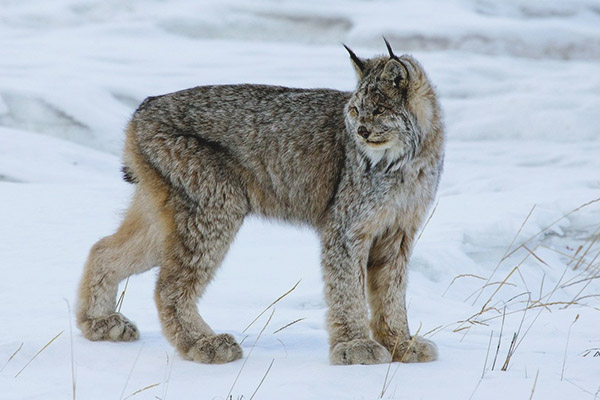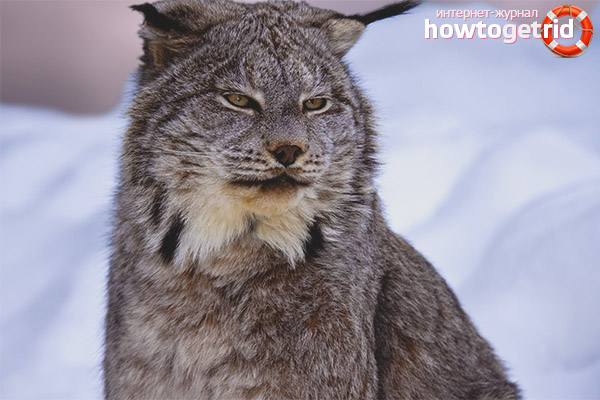The content of the article
By Canadian trot is meant a beast that is distinguished by its habitat. These individuals like the forest territory. They lead a rather closed lifestyle, but are very mysterious and interesting to learn. Like other varieties of this family, lynx differ in the habits of wild cats. They are famous for their grace. With regard to distribution, most of the population is dispersed throughout Canada, other inhabitants are found in the vast northern part of the United States.
Description
- These individuals are ranked as medium-sized, similar to the red lynx. By coat color they can be brown-yellow, light brown or gray-yellow. The upper torso is darkened, the bottom is brightened and stands out in tone from the rest of the body sections. Most members of the family have dark spots.
- The tail is short, black pigment is present at the end.The coat is long and dense, thanks to which the animals are protected from bad weather conditions. When the cold is just around the corner, whiskers begin to grow around the lynx. They cover the cervical region and also partially protect.
- Ears on the format of a triangle with black tassels at the ends, which are pulled up to 4 cm. The limbs are fluffy and large, the animal moves well in the snow, without feeling discomfort. The limbs in the back are longer, about the same as in lynx pigmented red. Along the length of the body, animals grow to 1 m. On average. In addition, the tail is given about 15 cm. The height at the withers is 0.5 m. The weight category is in the range 4.5-17 kg.
- The differences in gender are only in that the male members of the family are slightly larger than the females. If we compare the variety under discussion with the common trot, the latter is twice as large.
- In animals, the jaws are equipped with four most powerful canines, and the entire dentition consists of 28 teeth. The lynx feel the bite area of the victim with the help of the canines. Due to this, they have the opportunity to damage the prey of a lot of nerve endings. Retractable claws, sharp and strong.
- Comparing the data of individuals with red representatives of the family, it should be said that the first less reddish in pigmentation. They also have a longer brush at the ends of the ears, the spotting appears clearer, the tail is shorter, and the limbs are stronger and larger. Red animals are small in size.
Nutrition
- Most of the basic menu is given to meat, per day an individual should eat it in the amount of 3 kg. This is required for a full existence. Most often lynx hunt hares, for the year an individual kills about 200 eared. Thanks to this, it is possible to adjust the population, because hares breed quickly.
- In addition, the diet may include deer, squirrel, beaver, mouse, bird, fish, snow ram. If the animal does not eat the food it has taken right away, it hides food and returns to stocks later.
- Usually, a hole in the soil serves as a cache. Small predators search for stocks of lynxes, take them away and divide them among themselves. When an animal is full, it does not prepare for a hunt, but calmly slack in its lair.
Behavior
- It was already mentioned earlier that individuals are characterized by a hidden image of being.They rarely communicate with each other, but they cannot make friends because of the nomadic nature of their stay. Usually the individual occupies the territory on which it hunts (more than 70 sq. M.). The territory is marked with urine and scratches.
- Thanks to its powerful and fluffy paws, the lynx confidently and quickly moves across the snow cover. It does not matter what it is, loose or icy. Moreover, the individual covers the traces, also feels great in the water space, can skillfully climb trees and rocks.
- When a mammal is in search of food, it is able to overcome more than a dozen kilometers. Especially if there is no feed in the distribution area. When the weather is bad, the lynx will wait it out and set off again. It can cross sections even in the coldest water.
- The distinctive characteristic of the representatives of the family under discussion is that it is not only after sunset that they hunt. Individuals are adapted to the production of food during the day, which is not the case with common trots. The animal looks out for prey down, then rushes jumps of 3 meters in length.
Area
- The considered individuals mainly live throughout Canada. Wild animals are most commonly found in areas of Washington, Idaho, and Western Montana. Presented cats in small populations live in Utah and New England.
- Very rarely, such animals can be found in Colorado, Oregon and Wyoming. Forests with dense vegetation are predominantly considered habitual habitats of the represented individuals. However, cats feel well in open forests, tundra, and rocky terrain.
Breeding
- It is noteworthy that individuals converge in pairs exclusively in the mating season. This time starts from the end of winter and lasts until the middle of spring. Male independently chooses several females on its territory. After he fertilizes his companions, he is removed about his business.
- In the future, only the mother takes care of the offspring. After the marriage period, the pregnancy period lasts about 2 months. Before giving birth, the female finds a secluded, safe den, and then settles it. Most often, the house is selected in the crevices of rocks, dense vegetation and hollows of trees.
- Then, for several days, the mother expects the birth of offspring. Often, up to 5 kittens are born. Each weighs no more than 350 grams. At this time, the kids are blind, deaf and completely helpless. Without maternal protection and guardianship, they will not survive. After half a month, they see their sight.
- It is noteworthy that such small clumps with bright blue eyes will soon grow into ruthless predators. The first few months, the young continue to be fed breast milk. Already from 4 months, solid food gradually begins to enter their diet. Mother tries to feed babies with rabbit.
- All the subtleties of hunting kittens are trained gradually. For prey, the mother takes her cubs already from six months. At this time they are watching the whole process of hunting. Literally, when babies turn 10 months old, they are forced to leave their mother. She, in turn, begins to prepare for the mating season.
- The ruminants already live a full independent life. Otherwise, soon they reach puberty and begin to look for a mate for themselves. They choose their own territory and begin to settle in. On average, such cats live about 10 years under natural conditions.
It is not fully understood how the individuals in question relate to man. For example, in the wild, such cats try to avoid people in every possible way. But at the same time, lynxes do not experience any fear. On the other hand, the animals in question often lodge nearby settlements. They can sometimes go there.
Video: Canadian lynx (Lynx canadensis Kerr)













To send